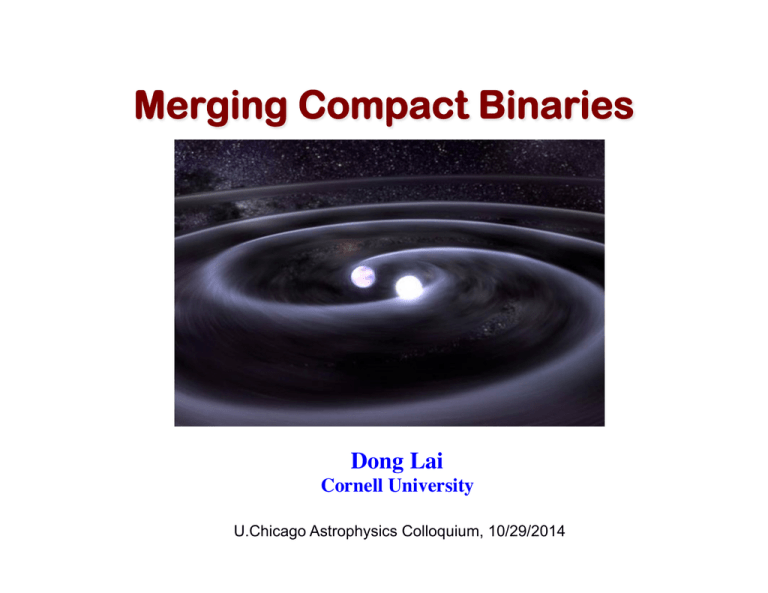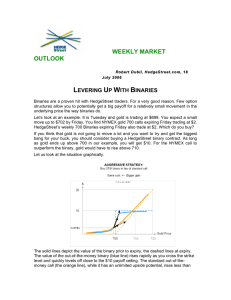Merging Compact Binaries - Cornell Astronomy
advertisement

Merging Compact Binaries Dong Lai Cornell University U.Chicago Astrophysics Colloquium, 10/29/2014 Merging Compact Binaries 1. Neutron Star/Black Hole Binaries 2. White Dwarf Binaries Transient & Variable Universe Wide-field, fast imaging telescopes in optical: PTF(iPTF,ZTF) Pan-Starrs LSST Transient & Variable Universe Wide-field, fast imaging telescopes in optical: PTF, Pan-Starrs, LSST Gravitational Wave Astronomy LIGO VIRGO Merging NS and BH Binaries NS/NS Binaries: Binary Pulsars Nobel Prize 1993 Hulse-Taylor Pulsar Weisberg et al. 2010 NS/NS Binaries: Binary Pulsars Double pulsars Kramer et al. 2014 Hulse-Taylor Pulsar Weisberg et al. 2010 NS/NS Binaries: Binary Pulsars Double pulsars Kramer et al. 2014 Hulse-Taylor Pulsar Weisberg et al. 2010 (Based on 3 systems in Galaxy that will merge within Hubble time; No observed NS/BH and BH/BH yet !) NS-NS Merger Shibata et al. 2006 BH-NS Merger F. Foucart et al (Cornell) 2011,13 Ph.D.’11CITAUCB BH-BH Merger Cornell-Caltech collaboration The last few minutes: Gravitational Waveform Gravitational Waves • Warpage of Spacetime • Generated by time-dependent quadrupoles • Detector response to passage of GWs: Gravitational Wave Interferometer Kip Thorne iLIGO: reached h~10-21 (2006) eLIGO: h ~ 1/2 smaller (2010) aLIGO: h ~1/10 smaller (2018?), reach 200 Mpc Kip Thorne Gravitational waves probe nonlinear gravity Cornell-Caltech collaboration Gravitational waves probe NS EOS Masses well measured from inspiral waveform Final cut-off frequency ~ (GM/R3)1/2 Cutler et al. 92; DL & Wiseman 96; Shibata et al. 06; … Bauswein, Janka... 12,14 NS/NS and NS/BH Mergers: Electromagnetic Counterparts Gamma-Ray Bursts --Bursts of 0.1-10 MeV gamma-rays --From all directions, z~0.1-10 --Very energetic ~1048-55 erg --Rare: GRB rate ~ 10-6/yr/galaxy -- Long (~30s) and short (~0.3s) Merging NS/BH (or NS/NS?): Central Engine of Short GRBs Bloom et al. 2006 GRB Elliptical z=0.2 Properties of host galaxies: Fong et al. 13 Merging NS/BH and NS/NS: Optical/IR Transients (?) Foucart et al. (Cornell-Caltech) Ejecta evolution: Initially mostly hot neutrons, decompression, r-process, beta decays heating Matzger, Quataert, etc. Pre-Merger Phase: Anything interesting? Pre-Merger Phase: Non-magnetic Neutron Stars Tides -- Equilibrium tides -- Dynamical tides Equilibrium Tide M M, R (Missing GW cycles) ==> Important only at small separation (just prior to merger) (Bildsten & Cutler 1992; Kochenek 92; DL, Rasio & Shaipro , etc) Numerical GR Quasi-equilibrium NS binary sequence (Baumgarte, Shapiro, Teukolsky, Shibata, Meudon group, etc. 1990s--200x) Recent (semi-analytic) GR calculation of tidal effect (Hinderer, Flanagan, Poisson, Damour, Penner, Andersson, Jones, etc., 2008+) Dynamical Tides: Excitations of Internal Waves/Modes NS has low-frequency oscillation modes: g-modes (~100 Hz) (depends on symmetry energy) inertial modes (incl. r-modes),… Resonance: Dynamical Tides: Excitations of Internal Waves/Modes Rosonant tidal excitations of NS modes during inspiral transfer orbital energy to NS Missing GW cycles ==> Probe NS EOS using Inspiral Waveform Resonant Excitations of NS Oscillations During Inspiral Non-rotating NS: G-mode (Reisenegger & Goldreich 94; Shibata 94; DL 94) Rotating NS: G-mode, F-mode, R-mode (Ho & DL 99) Inertial modes (DL & Wu 06) R-mode (excited by gravitomagnetic force; Racine & Flanagan 06) General Results: • For R=10 km NS, the number of missing cycles < 0.1, bearly measurable (unless NS is rapidly rotating) • Number of missing cycles Important for larger NS Resonant Excitations of NS Oscillations During Inspiral Non-rotating NS: G-mode (Reisenegger & Goldreich 94; Shibata 94; DL 94) Rotating NS: G-mode, F-mode, R-mode (Ho & DL 99) Inertial modes (DL & Wu 06) R-mode (excited by gravitomagnetic force; Racine & Flanagan 06) New Results: • G-modes: Systematic exploration of nuclear symmetry energy with existing constraints ∆N can be ~ 1 (W. Newton & DL 2015) • Crustal modes: -- Could shatter crust, pre-cursor of short GRB (Tsang et al. 12) -- Resonant excitation of spheroidal shear modes David Tsang Ph.D.10 CaltechMcGill Pre-Merger Phase: Magnetic NSs Cf. Double Pulsars: PSR J0737-3039A,B pulsar A: ~1010G pulsar B: ~a few x1012G Consider a binary with -- magnetic NS (>1012G) + non-magnetic NS -- embedded in a tenuous plasma (magnetosphere) B Flux tube Flux tube DC Circuit Powered by Orbital Motion DC Circuit Powered by Orbital Motion Applications to: WD-WD Binaries (K.Wu et al. 02,09; Dall’Osso, Israel, Stella 06,07 ) NS-NS, NS-BH Binaries (Hansen & Lyuitikov 01; McWilliams & Levin 11; Piro 12) Exoplanetary systems (Laine & Lin 12,…) Caution: Some of these were wrong DC Circuit Powered by Orbital Motion Results depend on the resistance: DC Circuit Powered by Orbital Motion Problems with small (large Flux tube is twisted ): DC Circuit Powered by Orbital Motion Circuit will break when ~ Energy Dissipation in the Magnetosphere of Pre-merging NS Binary DL 2013 Actual dissipation rate: • This Edot will not affect orbital decay rate (GW signal) • Radio emission prior to binary merger (?) cf. isolated pulsars: cf. Vietri 96; Hansen & Lyutikov 01 Energy Dissipation in the Magnetosphere of Pre-merging NS Binary Q: What happens if both NSs are magnetic? Ponce… Lehner …2014 Compact White Dwarf Binaries (mins - hour) Compact White Dwarf Binaries (mins - hour) -- Dominant sources of gravitational waves (10-4-0.1 Hz) Space interferometer (eLISA-NGO??) -- Lead to various outcomes: R CrB stars, AM CVn binaries, transients If total mass ~ 1.4Msun: AIC => NS or SN Ia Type Ia Supernovae Type Ia Supernovae Thermonuclear explosion of CO white dwarfs of ~1.4Msun Progenitors ?? WD + non-deg. star: Single-degenerate Scenario WD + WD merger: Double-degenerate Scenario WD + WD collision ? Various arguments for/against each scenario: Rates, super-soft sources, delay time… Recent observations in favor of DD: e.g., Absence of ex-companion stars in SN Ia remnant SNR 0509-67.5 ==> rule out V=26.9 Schaefer & Pagnotta 2012 (cf Di Stefano & Kilic 2012; Shen et al.13) Radial Velocity Surveys of Compact WD Binaries Brown et al. 2012 Brown et al. 2013 12 min orbital period double WD eclipsing binary SDSS J0651+2844 Primary & secondary eclipses Ellipsoidal (tidal) distortion Doppler boosting Brown et al. 2011 -- will merge in 0.9 Myr -- large GW strain (eLISA verification source) -- orbital decay measurable from eclipse timing (Hermes et al 2012) 20 min double WD binary WD0931+444 (Kilic et al. 2014) WD Binary Merger Dan, Rosswog,et al. 14 WD Binary Merger Transient sources WD Binary Merger Dan, Rosswog,et al. 14 Outcome depends on WD masses, composition, and pre-merger conditions (rotation) Dynamical Tides in Compact WD Binaries with Jim Fuller (Ph.D. 2013 DuBridge Fellow, Caltech/KITP) Issues: -- Spin-orbit synchronization? -- Tidal dissipation and heating? -- Effect on orbital decay rate? (e.g. eLISA) Fuller & DL 2011-2014 Equilibrium Tide M M, R Problems: -- Parameterized theory -- The physics of tidal dissipation is more complex: Excitation/damping of internal waves/modes (Dynamical Tides) Wave Propagation inside White Dwarf N = Local Buoyancy Freq CO WD He-core WD Continuous Excitation of Gravity Waves Waves are excited in the interior/envelope, propagate outwards and dissipate near surface Continuous Excitation of Gravity Waves Waves are excited in the interior/envelope, propagate outwards and dissipate near surface AA AA Spin-Orbit Synchronization 1 hour Tidal Heating Rate Consequences of Tidal Heating Depend on where the heat is deposited … If deposited in shallow layer: thermal time short ==> change Teff Explain SDSS J0651+2844 If deposited in deeper layer: (common: critical layer…) thermal time longer than orbital ==> Nuclear flash * Tidal Nova Summary • Merging NS and BH Binaries: -- May be detected this decade by advanced LIGO/VIRGO -- Most severe test of gravity -- Probe NS EOS: Resonant excitations of modes -- EM counterparts: GRBs, Optical/IR detectable by LSST (?), pre-merger magnetic interactions precursors (??) • Merging WD Binaries: -- Being detected in recent/ongoing surveys -- Produce various outcomes (e.g. SN Ia), transient sources (PTF/ZTF, LSST) -- Pre-merger phase important/interesting: dynamical tides: Continuous excitations of waves, nonlinear breaking spin synchronization, tidal heating Tidal nova -- Low-frequency GWs (eLISA?) Thanks! Transient & Variable Universe PTF, Pan-Starrs, LSST Wide-field, fast imaging telescopes in optical: PTF11agg ï26 46 10 iPTF13dsw ï24 Relativistic Explosions 45 Luminous Supernovae 10 SCP06F6 SN2005ap SN2006gy iPTF13bxl PTF10cwr SN2008esPTF09cnd 44 PTF09cwl PTF09atu 10 Thermonuclear Supernovae SN2002bj ï18 PTF10bhp PTF12bho .Ia Explosions PTF11bij ï16 PTF10xfh SN2007ke PTF09dav PTF11kmb SN2012hn PTF10iuv SN2005E 43 10 CoreïCollapse Supernovae 42 10 Caïrich Transients SN2008ha ï14 41 Intermediate 10 Luminosity NGC300OT Red Transients 40 PTF10fqs 10 SN2008S PTF10acbp ï12 P60ïM82OTï081119 ï10 Classical Novae M85 OT Luminous V838 Mon Red Novae M31 RV Peak Luminosity [erg sï1] SN2007bi ï20 V Peak Luminosity [M ] ï22 39 10 ï8 P60ïM81OTï071213 38 ï6 ï4 ï1 10 10 V1309 Sco 0 10 1 10 Characteristic Timescale [day] 2 10 Kasliwal 2014


